How to Use Linkable Assets for Link Building
Jan 30, 2024
Written by Casey Bjorkdahl

Casey Bjorkdahl is one of the pioneering thought leaders in the SEO community. In 2010, Casey co-founded Vazoola after working for a Digital Marketing Agency for five years in New York City. Vazoola is now one of the fastest growing and most widely recognized SEO marketing firms in the country.
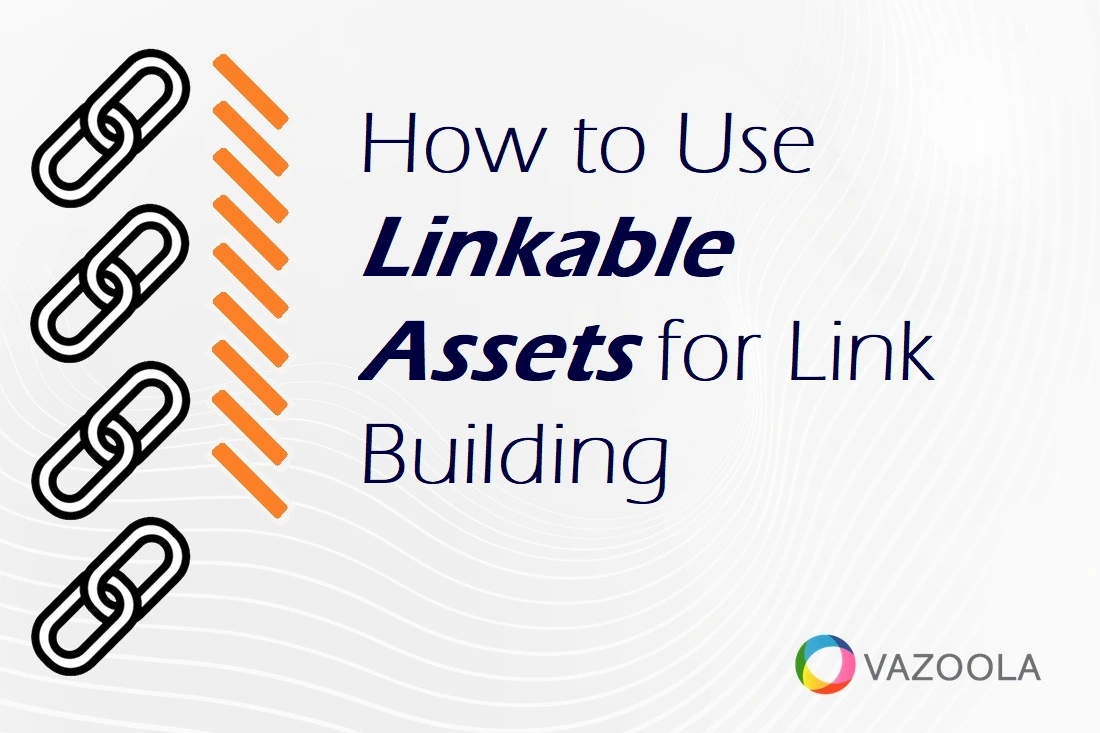
Mastering the art of link building is crucial for enhancing a website's online visibility and search engine rankings. After all, too many websites will never attract any links whatsoever.
At Vazoola, we understand the power of a linkable asset. They aren't merely online tools for building links; they are the keys to successful link building campaigns and overall SEO strategy.
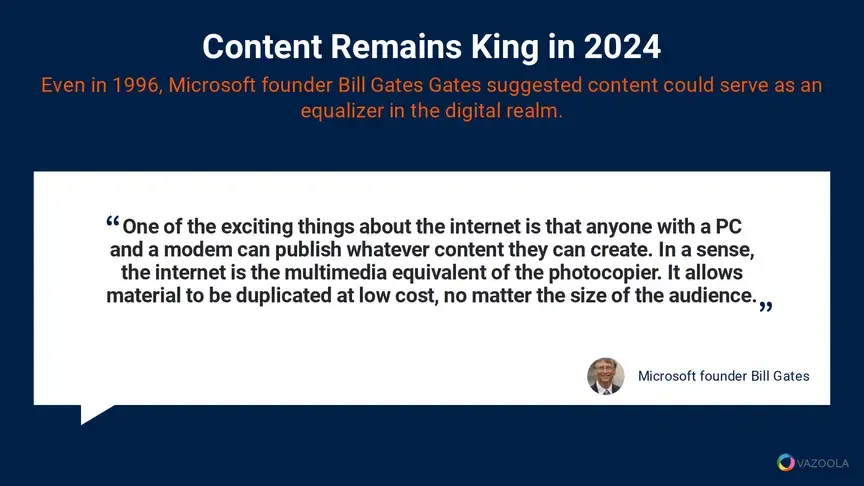
Key Takeaways:
-
Linkable assets are high-quality, valuable content pieces designed for a link building campaign, and their creation process involves a blend of creativity, research, and audience understanding.
-
Content-driven link building drives traffic, strengthens domain authority, enhances user experience, increases organic visibility, and offers scalability in SEO efforts.
-
The strategic process of creating a linkable asset includes identifying the audience, analyzing competitors, determining keywords, employing the skyscraper technique, creating and promoting content, measuring performance, and revising strategies.
-
Online tools like Chat GPT, SEMrush, BuzzSumo, and Canva help with your link building campaign by identifying link opportunities and optimizing the creation of linkable assets.
-
A linkable assets is significant in shaping a brand's digital legacy, with an emphasis on the transformative power of well-crafted content in link building efforts.
Table of Contents
What Is a Linkable Asset in SEO?
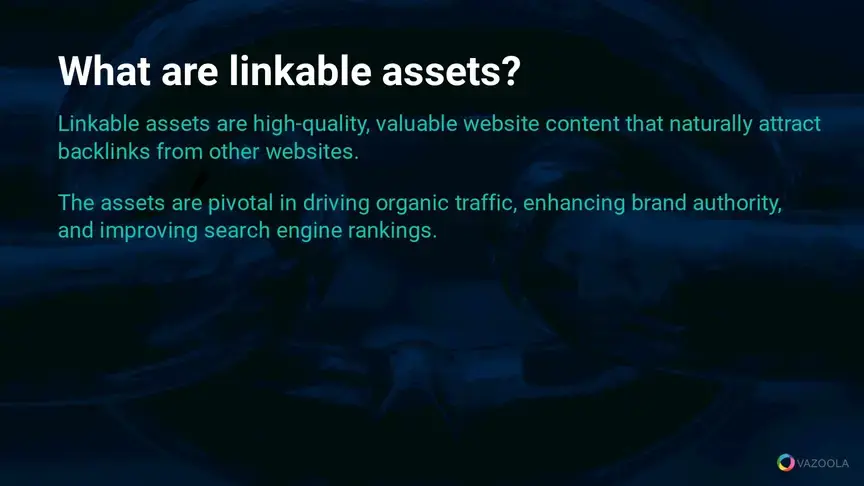
What are linkable assets?
The question perhaps can be answered by asking another: Why should referring domains link to you?
Linkable assets are high-quality, valuable website content that naturally attract quality backlinks from other relevant websites and referring domains in the same niche. For example, an SEO blog probably would be interested in linking to a small business blog, but is unlikely to link back to a restaurant.
Every linkable asset is pivotal in driving organic traffic, enhancing brand authority, and improving search engine rankings.
At their core, linkable content assets provide significant value to both the audience and referring domains, making them worthy of backlinks. After all, not many websites find it worth linking to your product pages, sales pages or service pages.
Linkable assets serve as magnets for external links, key factors in search engine ranking algorithms. Offering unique, informative, or entertaining content encourages other sites to reference and link to it, thereby boosting the site's credibility and visibility in search engine results.
Creating linkable assets for SEO involves a blend of creativity, thorough research, and an understanding of what resonates with the target audience of referring domains.
Our experience at Vazoola has shown that the most effective linkable asset is one that addresses specific needs or interests of the audience, providing them with valuable insights or solutions. Simply put, the best linkable asset is one that people link to.
Why Should You Attract Links With Content?
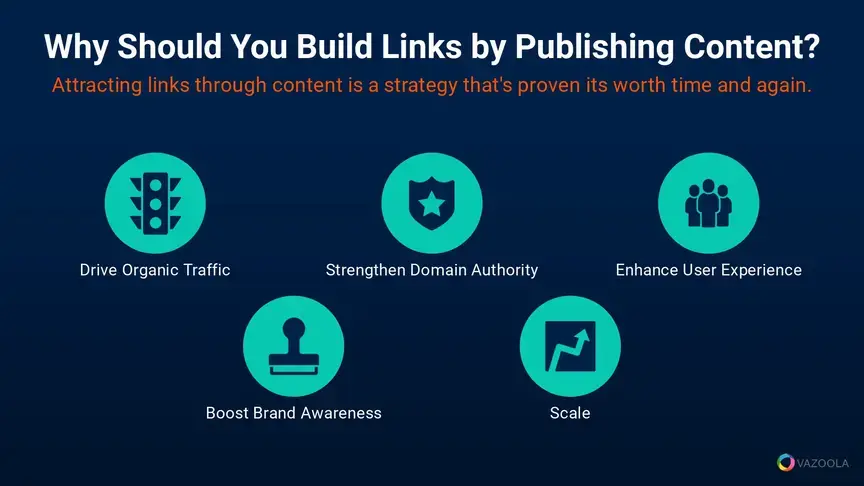
About 41% of digital marketers surveyed by uSERP said content marketing provides the strongest passive link building results. It's no wonder why linkable asset creation was the favored link building strategy according to an Aira study.
Attracting links through content is a strategy that's proven its worth time and again in. Here at Vazoola, we've seen firsthand how this approach not only enhances a website's performance but also solidifies its standing in the competitive online space.
When using digital PR to earn quality backlinks, you have to think like a PR and execute like an SEO.
— Mos Clement (@MosClement) February 7, 2023
Digital PR isn't about pitching promotional pieces of content with a press release but instead promoting linkable assets with a solid outreach strategy.
Why should you attract links with content? While a plethora of reasons could be named, consider the following reasons to create linkable assets:
-
Drive Organic Traffic:
One of the primary reasons to create a linkable asset is to drive traffic to your website. When other sites link to your content, they essentially direct their audience to you, increasing your site's visibility and visitor count.
Such an influx of traffic is not just about numbers; it's about bringing in an audience that is already interested in what you have to offer, as they've been referred by a trusted source.
-
Strengthen Domain Authority:
Linkable assets play a crucial role in strengthening a website's domain authority.
In our experience, websites with high-quality backlinks from reputable sources tend to be viewed more favorably by search engines. This enhanced authority not only boosts your site's credibility but also its potential to rank higher in search engine results pages.
-
Enhance User Experience:
Quality content that serves as a good linkable asset invariably enhances the user experience. These assets provide valuable information, solve problems, or offer unique insights, making your website a go-to resource for users.
An improved user experience leads to higher engagement, longer visit durations, and, ultimately, a stronger connection with your audience.
-
Boost Brand Awareness and Visibility:
Organic visibility is key to long-term digital marketing success. Each optimal linkable asset contributes significantly to this goal by earning natural backlinks that signal to search engines the value and relevance of your content.
An organic approach to build links and visibility is sustainable and often more effective than paid advertising in the long run. Likewise, by using branded colors and styles in your linkable assets, you can organically boost brand awareness among target audiences.
-
Scale:
Finally, linkable assets offer a scalable way to grow your online presence.
Once created, these assets continue to attract backlinks and traffic over time, often with minimal additional effort or investment. Scalability is crucial for businesses looking to expand their reach and impact in a cost-effective manner.
What Qualities Make a Linkable Asset?
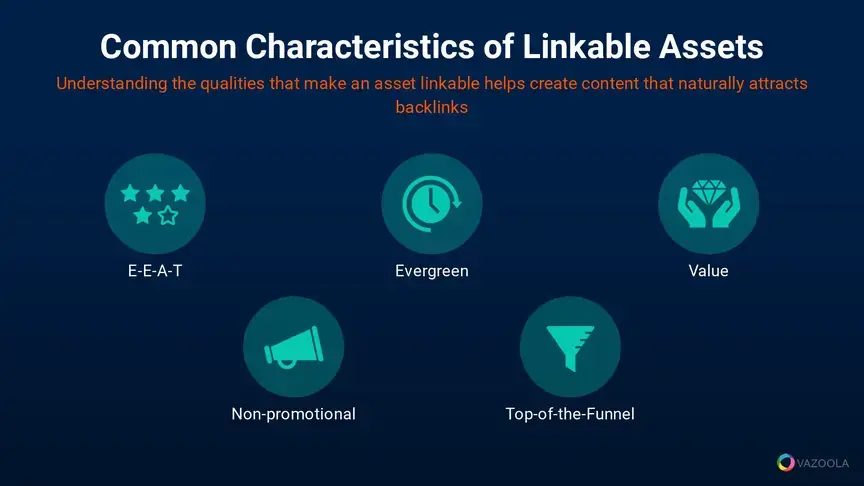
Understanding the qualities that make an asset linkable is crucial for creating content that naturally attracts backlinks from other pages.
At Vazoola, we have learned that certain characteristics consistently contribute to the linkability of online content.
E-E-A-T
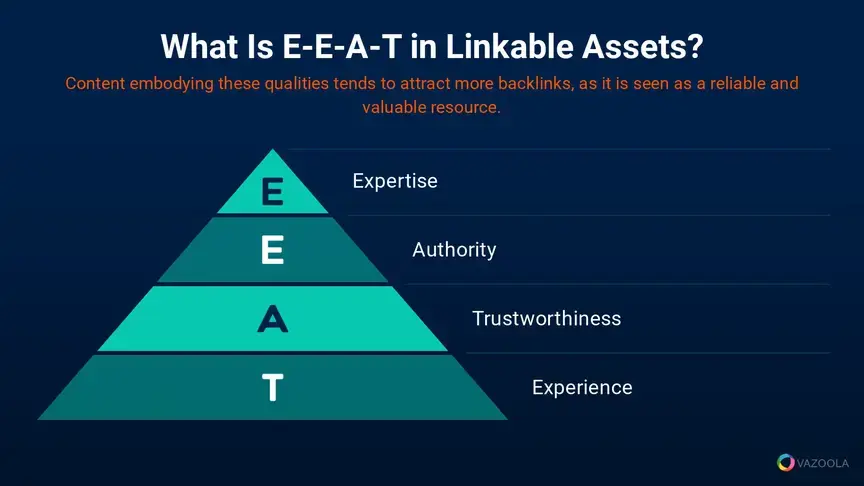
E-E-A-T stands for Expertise, Authoritativeness, Trustworthiness, and Experience, the pillars that define the credibility of content. Google values content that demonstrates a deep understanding of the subject, is created by authoritative sources, and is trustworthy in the eyes of the audience.
Our experience has shown that content embodying these qualities tends to attract more backlinks, as it is seen as a reliable and valuable resource.
Evergreen
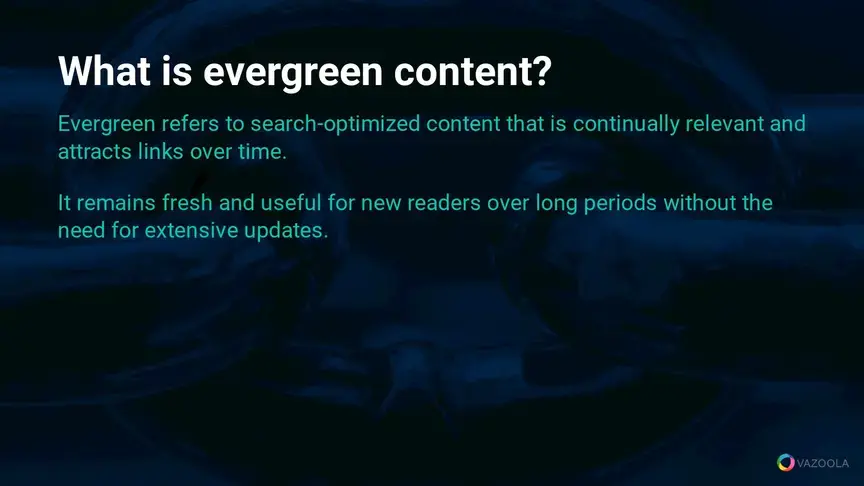
Evergreen content remains relevant and useful over time, continuing to attract visitors and earn links long after its initial publication. The timeless content typically addresses fundamental topics, offers timeless advice, or provides solutions to ongoing challenges.
At Vazoola, we recommend focusing on evergreen topics to ensure your content remains a consistent draw for backlinks.
Value
Value is at the heart of linkable assets. Content that has relevant links offers unique insights, comprehensive information, or practical solutions is more likely to be linked to.
We have seen that content which genuinely helps the audience, whether through solving a problem, providing in-depth analysis, or offering actionable advice, naturally attracts backlinks.
Link Building Tip: Incorporate linkable assets into your SEO strategy. Linkable assets:
— Uprankly (@uprankly) December 17, 2023
- boost rankings,
- drive organic traffic,
- elevate your online presence.
Non-promotional Message
While it's tempting to use content as a direct promotional tool, our experience has shown that overtly promotional content often fails to attract backlinks. Instead, focusing on providing value without a sales pitch makes the content more linkable.
Educational, informative, or entertaining content that prioritizes the audience's needs over promotional messages tends to be more successful and earn links.
Top-of-the-Funnel
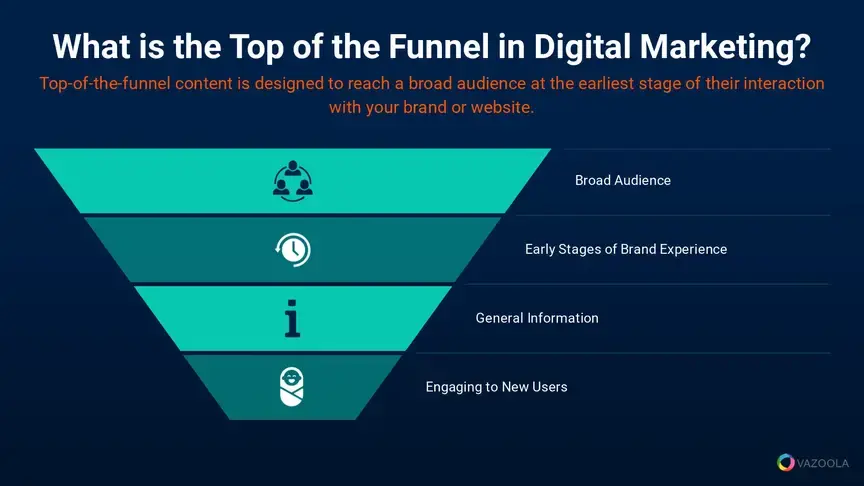
Top-of-the-funnel content is designed to reach a broad audience at the earliest stage of their interaction with your brand or website. This type of content is often more general, aiming to attract and engage users who are just beginning to explore a topic.
By addressing common questions, general interest topics, or introductory information, top-of-the-funnel content can draw in a wide range of backlinks from various sources.
How to Create Linkable Assets in 8 Simple Steps
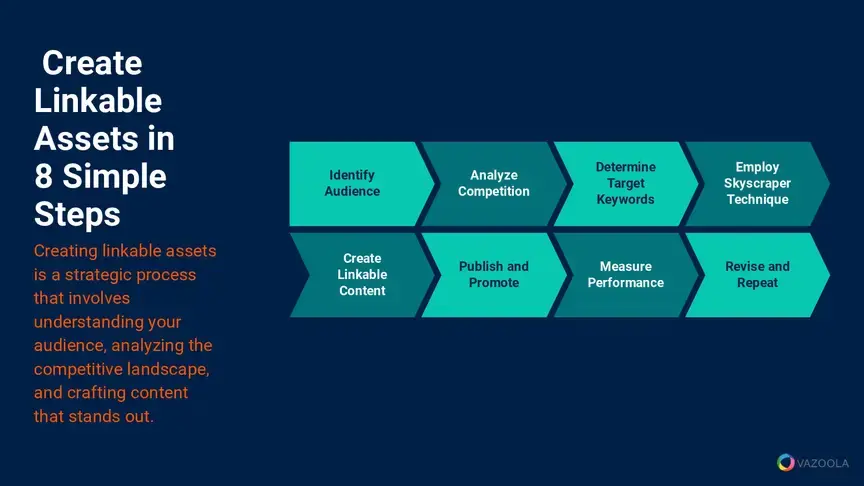
Creating content for linkable assets is a strategic process that involves understanding your audience, analyzing the competitive landscape, and crafting content that stands out. At Vazoola, we have honed this process to maximize the linkability of our content.
1. Identify Your Audience
The first step in creating linkable assets is to identify your target audience. Understanding who they are, what they need, and what interests them is crucial. This knowledge guides the creation of content that resonates with them, addressing their questions, challenges, and interests.
At Vazoola, we suggest conducting surveys, analyzing data on social media engagement, and monitoring audience feedback to gain insights into your audience's preferences.
Pro Tips:
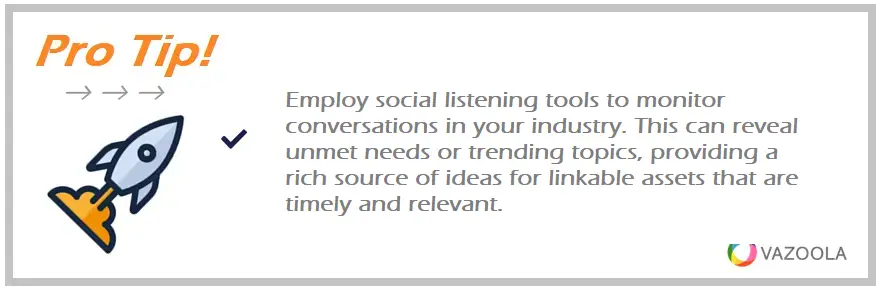
Employ social listening tools to monitor conversations in your industry. This can reveal unmet needs or trending topics, providing a rich source of ideas for linkable assets that are timely and relevant.
2. Analyze Competitor Content
Analyzing what content has been successful for your competitors provides valuable insights. This step involves looking at the content types that best earn links, and understanding why their content resonates with the audience.
Our experience has shown that this analysis can reveal gaps in the market that your content can fill.
3. Determine Target Keywords
Selecting the right keywords is essential for ensuring your content is discoverable and relevant. These keywords should align with your audience's search intent and the topics you want to be known for.
We recommend using keyword research tools to identify high-value keywords that your target audience is searching for.
Pro Tips:
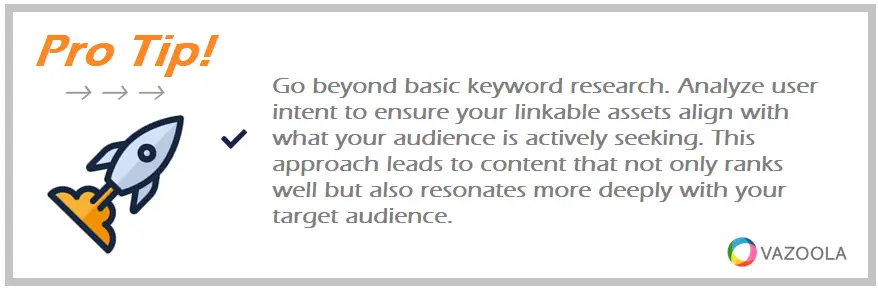
Go beyond basic keyword research. Analyze user intent to ensure your linkable assets align with what your audience is actively seeking. This approach leads to content that not only ranks well but also resonates more deeply with your target audience.
4. Employ the Skyscraper Technique
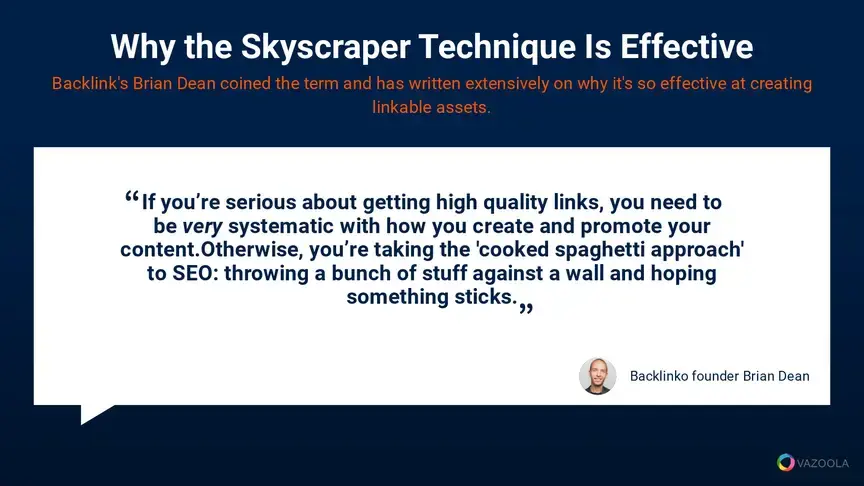
The Skyscraper Technique involves finding existing content that has performed well and then creating something better. This means making your content more comprehensive, up-to-date, and user-friendly. With any luck, it surpasses top ranking content.
Backlinko's Brian Dean coined the term, "skyscraper technique," after he created content that doubled his organic search traffic in just 14 days.
Our company has seen significant success with this technique, as it helps in creating high quality content content that is more likely to attract high quality links.
5. Create Linkable Content
Creating linkable content involves integrating the qualities of linkable content assets discussed earlier. This content should be valuable, evergreen, non-promotional, and demonstrate E-E-A-T.
We suggest focusing on original research, detailed guides, infographics, and interactive tools to make your content more engaging and link-worthy.
6. Publish and Promote Content
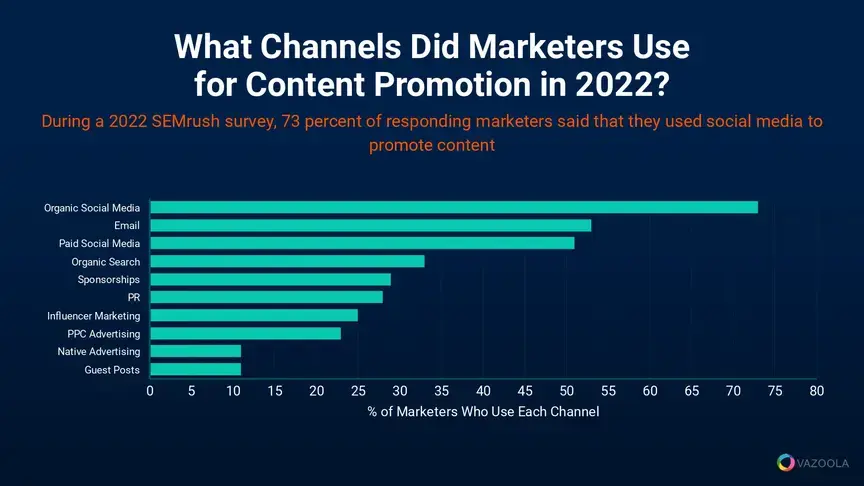
Once your content is created, it's time to publish and promote it. Sharing your content through social media, email newsletters, and other channels are all promotion efforts that increase visibility.
We have learned that outreach to industry influencers, bloggers, and other websites can also be effective in content promotion and link acquisition. Connect with the right influencer, and you could find yourself with a lot more than a single link.
In an SEMrush survey, content marketers advised what channels they most use to promote their linkable assets, with 73% relying on social media.
Pro Tips:
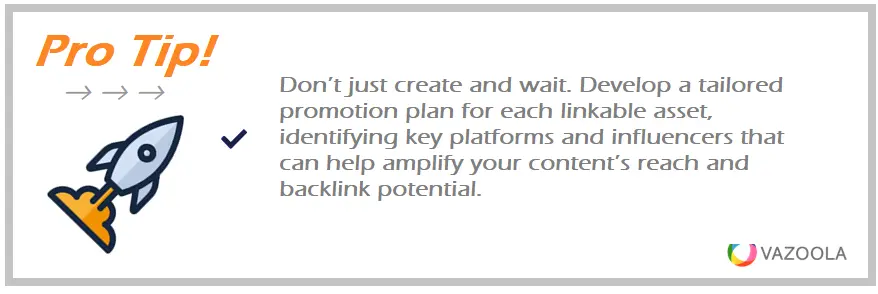
Don’t just create and wait. Develop a tailored promotion plan for each linkable asset, identifying key platforms and influencers that can help amplify your content’s reach and backlink potential.
7. Measure Content Performance
Measuring the performance of your content is crucial to understand its impact. This involves tracking metrics like traffic, backlinks, and engagement.
Tools like Google Analytics and backlink checkers can provide insights into how well your content is performing and where improvements can be made. This step requires patience, since it can take more than 3 months to see the impact of a link on search ranking, according to an AuthorityHacker study.
8. Revise and Repeat
Finally, the process of creating linkable assets is ongoing. Based on the performance metrics, revising and updating your content can enhance its effectiveness.
We recommend regularly reviewing and updating your content to ensure it remains relevant and continues to attract backlinks.
Pro Tips:
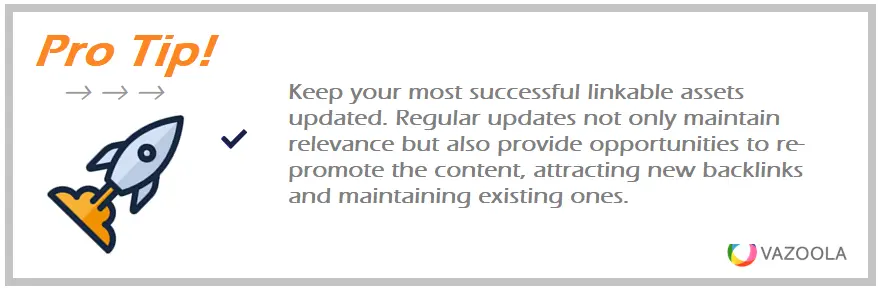
Keep your most successful linkable assets updated. Regular updates not only maintain relevance but also provide opportunities to re-promote the content, attracting new backlinks and maintaining existing ones.
14 Common Types of Linkable Assets
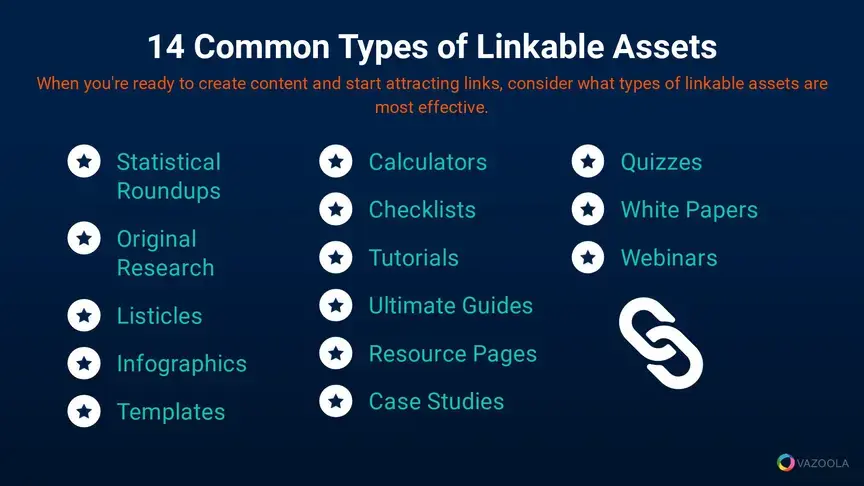
So, you're ready to create content and start attracting links. But what types of linkable assets are most effective? What sorts of articles, videos and other linkable assets will make other sites link back to yours?
At Vazoola, we have explored a wide range of these assets, each offering unique benefits in attracting backlinks and engaging audiences.
Pro Tips:
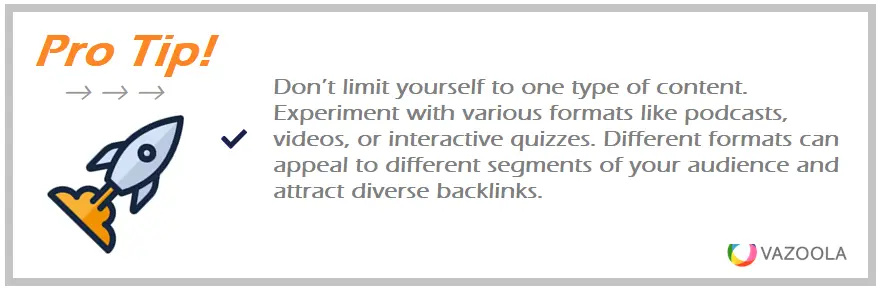
Don’t limit yourself to one type of content. Experiment with various formats like podcasts, videos, or interactive quizzes. Different formats can appeal to different segments of your audience and attract diverse backlinks.
Statistical Roundups
Statistical roundups gather and present data on specific topics, offering a comprehensive overview through numbers and trends. These assets are highly valued for their ability to condense vast amounts of information into accessible formats.
Content creators and industry professionals often seek out such roundups for reliable data to support their own articles, reports, or presentations. As a result, statistical roundups tend to attract a high number of backlinks, making them a powerful tool in any SEO strategy.
Original Research Studies
Conducting and publishing original research studies is a method we at Vazoola have found to be exceptionally effective in attracting backlinks. These studies provide fresh insights and data, contributing new knowledge to a particular field or topic.
Their originality and value make them a prime resource for other content creators, leading to citations and backlinks from various authoritative sources. Original research not only enhances a site's credibility but also positions it as a thought leader in its niche.
Listicles
Listicles, structured as easy-to-read lists, are a popular format for conveying information in a clear and concise manner. They can range from simple 'Top 5' lists to more detailed compilations, covering a wide array of topics.
The appeal of listicles lies in their straightforward format, which breaks down information into digestible chunks. This accessibility makes them highly shareable and attractive for linking, as they provide quick, valuable insights to readers.
Infographics
Infographics are a blend of visual and textual information, presenting complex data or ideas in a visually engaging format. Their ability to simplify and illustrate intricate concepts makes them highly shareable and linkable.
Infographics are not just about aesthetics; they are about making information more accessible. By transforming data into visual stories, they appeal to a broader audience, encouraging other websites and users to link to and share these visually compelling assets.
Templates
Templates offer practical solutions by providing a structured format for various tasks or projects. They are highly sought after for their utility and ease of use. Whether it's a business plan template, a social media calendar, or a budgeting spreadsheet, these tools save users time and effort.
Their practical nature makes templates valuable resources, leading to frequent sharing and linking by individuals and businesses alike who find these tools essential for their daily operations.
Pro Tip:
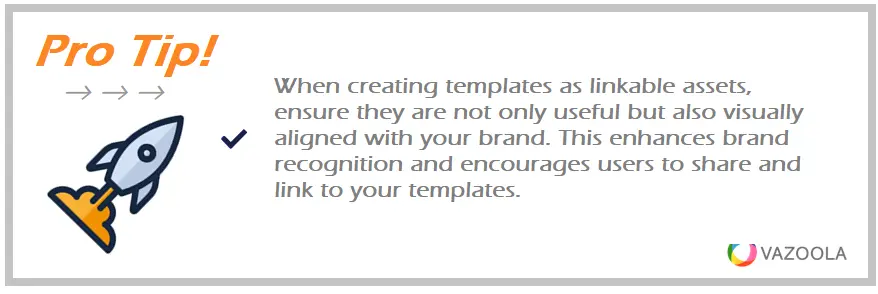
When creating templates as linkable assets, ensure they are not only useful but also visually aligned with your brand. This enhances brand recognition and encourages users to share and link to your templates.
Online Calculators
An online calculator is an interactive tool that serves a wide range of purposes, from financial calculations to health assessments. These linkable assets offer personalized answers to user queries, making them highly engaging and useful.
This interactivity and practical value lead to a high level of user engagement and sharing. Websites often link to these calculators as they provide a unique service that enhances the user experience, making them a valuable asset in any link-building strategy.
Checklists
Checklists are straightforward yet effective tools that guide users through various processes or tasks. They help ensure nothing is overlooked, whether it's for planning an event, conducting a review, or completing a project.
The simplicity and utility of checklists make them highly shareable. Users and businesses often link to checklists as they provide a clear, actionable path, making them an invaluable resource in numerous contexts.
Tutorials
Tutorials are comprehensive guides that provide step-by-step instructions on a particular task or topic. They are highly valued for their educational nature, helping users acquire new skills or knowledge.
Tutorials can range from simple how-to guides to more complex instructional content. Their detailed and informative nature makes them a go-to resource, often resulting in a high number of backlinks from users and websites seeking to share expert knowledge and practical guidance.
Ultimate Guides
Ultimate guides are comprehensive resources that cover a topic in extensive detail. A newly published guide is designed to be the definitive source of information on a given subject, offering depth, insight, and practical advice.
At Vazoola, we have found that ultimate guides attract backlinks due to their thoroughness and value as a one-stop resource. They appeal to both beginners seeking foundational knowledge and experts looking for in-depth analysis, making them widely linkable across various domains.
Resource Pages
A resource page compiles valuable information, tools, and links on a specific topic, serving as a hub for users seeking related content. These pages are highly linkable because they save users time and effort by aggregating useful resources in one place.
Our experience has shown that a well-curated resource page, offering a mix of both internal links and external links, is frequently referenced and linked to by other websites, content creators, or even another resource page..
Case Studies
Case studies are detailed analyses of specific instances or projects, often highlighting a problem, the approach taken to solve it, and the results achieved. They provide real-world examples and insights, making them valuable for readers seeking practical applications of theories or strategies.
Case studies are often linked to as they offer evidence of success or lessons learned, providing credibility and real-life context to theoretical concepts.
Quizzes

Quizzes offer an interactive and engaging way for users to test their knowledge or preferences on a topic. They are highly shareable and linkable due to their fun and engaging nature.
In fact, according to its own study, Mediafly found its customers who leveraged interactive content saw a 94% increase in content views than those leveraging traditional, static content.
The same study found interactive content experienced 52.6% more engagement than static content, and buyers spent an average of 8.5 minutes viewing static content items compared with 13 minutes on interactive content items.
Quizzes can be used for a variety of purposes, from educational tools to marketing instruments. Their ability to drive user engagement and provide personalized results makes them attractive for linking, especially when they offer unique insights or entertaining content.
White Papers
White papers are authoritative reports or guides that address specific issues, acting as a long form resource and offering solutions or insights. They are typically more formal and detailed than a blog post or an article, providing in-depth analysis and expert perspectives.
White Papers are often used in B2B contexts and are highly valued for their informational depth and professionalism. They are frequently linked to as reliable sources of information and thought leadership in a particular field.
Webinars
Webinars are online seminars or workshops that provide valuable information or training on a specific topic. They offer an interactive platform for experts to share knowledge and for participants to engage in real-time.
Webinars are linkable assets due to their educational value and the unique opportunity they provide for live interaction and learning. They are often referenced and linked to as sources of expert knowledge and as opportunities for continued learning and professional development.
Employ Tools to Identify, Create, and Promote Linkable Assets
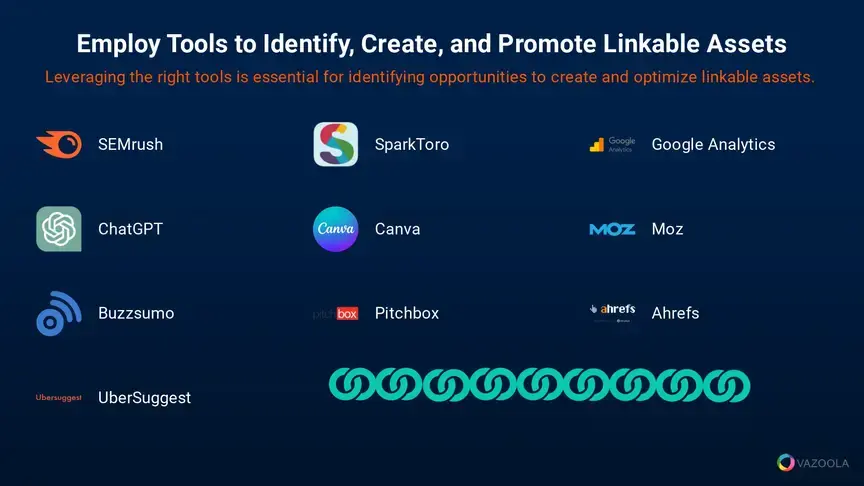
To know how to find linkable assets, leveraging the right tools will be essential for identifying opportunities to create and optimize linkable assets.
The following tools provide insights into audience preferences, competitor strategies, and market trends, guiding content creators in developing assets that resonate with their target audience and attract backlinks.
-
Chat GPT:
Chat GPT, with its advanced natural language processing capabilities, offers a unique approach to content ideation and development. It can assist in generating content ideas, titles, and even outlines based on current trends and user queries.
This tool is particularly useful for brainstorming and refining content strategies, ensuring that the created assets are both relevant and engaging.
-
SEMrush:
SEMrush is a comprehensive tool that offers insights into keyword research, competitor analysis, and SEO opportunities. It helps in identifying high-potential keywords and topics that your audience is searching for.
Likewise, SEMrush's ability to analyze competitor content strategies provides valuable insights into what types of linkable assets are successful in your industry.
-
BuzzSumo:
BuzzSumo is an excellent tool for discovering popular content within your niche. It allows you to see what topics are trending and which types of content are receiving the most shares and backlinks.
This information is invaluable for creating linkable assets that are likely to resonate with your audience and attract attention from other websites.
-
UberSuggest:
UberSuggest provides detailed keyword insights and content suggestions. It helps identify keywords that have high search volume but low competition, making them ideal targets for linkable assets.
The tool also offers content ideas and insights into the types of content that are performing well for these keywords.
-
Canva:
Canva is an indispensable tool for creating visually appealing content, a key component of so many links. Its user-friendly interface and vast array of templates make it accessible for any amateur designer, link building team or small business owner.
Whether it's for enhancing a blog post, creating an infographic, or designing a cover for a white paper, Canva is a valuable tool in the arsenal of anyone looking to create link-worthy content.
-
SparkToro:
SparkToro is a tool that focuses on audience intelligence. It helps identify where your audience spends their time online, what they read, and who they follow.
This information is key to creating linkable assets that not only attract backlinks but also reach the right audience.
-
Google Analytics:
Google Analytics is essential for measuring the performance of your linkable assets. It provides data on how users interact with your content, including page views, bounce rates, and conversion rates.
The information helps in refining your content strategy and understanding which types of assets are most effective in attracting and engaging your audience.
-
Pitchbox:
Pitchbox is an outreach and link-building tool that streamlines the process of connecting with influencers and potential link partners.
It helps identify opportunities for guest posting, collaborations, and link exchanges. Pitchbox is valuable for promoting your linkable assets and increasing their visibility and backlink potential.
-
Moz:
Moz offers a suite of tools for SEO, including link analysis and keyword research. It helps identify link-building opportunities and understand the backlink profile of your website.
Moz's insights are crucial for developing a strategic approach to creating and promoting linkable assets.
-
Ahrefs:
Ahrefs Site Explorer is a powerful tool for analyzing backlinks and exploring content opportunities. It provides detailed insights into the backlink profiles of your competitors, helping you understand what types of content are earning them links.
Ahrefs is also useful for tracking the performance of your own linkable assets, allowing you to see which ones are most successful in attracting backlinks. Ahrefs
Boost Your SEO Efforts By Publishing Linkable Assets
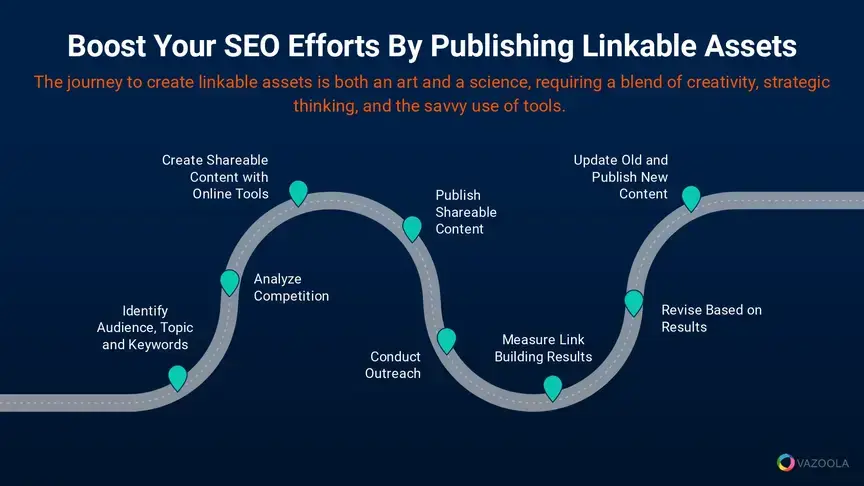
The creation and optimization of linkable assets is a critical element of successful SEO strategies.
At Vazoola, we've witnessed firsthand the transformative power of well-crafted content in elevating a brand's online presence and authority.
The journey to create linkable assets is both an art and a science, requiring a blend of creativity, strategic thinking, and the savvy use of tools.
We invite you to explore the potential of linkable assets in your own strategy, harnessing the insights and tools discussed to craft content that resonates, engages, and endures.

